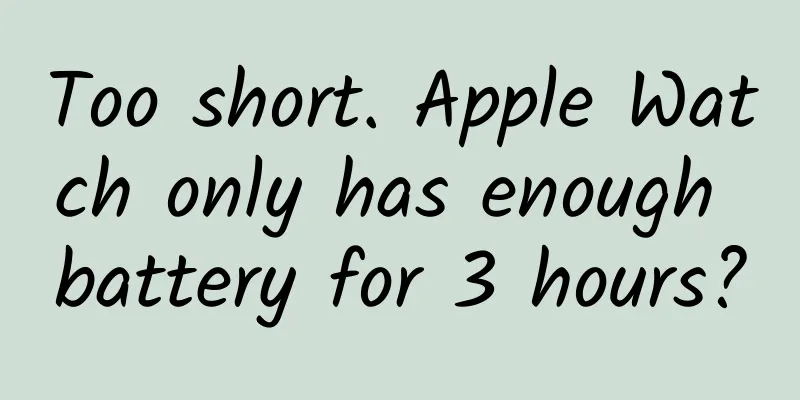Three ways Apple products die

|
Apple is a company known for its streamlined product line. In its 43-year history, Apple has rarely launched "experimental" products, and has always been cautious and focused, doing its best to make each product the best one. But this does not mean that Apple has never ruined its own products. On the contrary, in the process of keeping its product line streamlined, Apple has also "eliminated" many products. Among them are the iPod that has gone with the times, the AirPort that was sacrificed by Apple's strategy, and the AirPower that was eventually abandoned because of technical problems. Below, Geek Park summarizes several of the most well-known "deceased" Apple products. During this Qingming Festival, let's remember the star products that died at the hands of the giant. iPod (2001-2017) Seeing this, some people will definitely say, how can the iPod be dead? Isn’t the iPod touch still sold on Apple’s official website? But the iPod touch is more like a Wi-Fi version of the iPhone that can’t make calls, rather than a pure "music player." In 2001, Jobs released this music player that can be put in your pocket. He first explained why music is a huge industry because "everyone loves music", and then compared the pros and cons of various music players. Finally, he took out the first generation iPod that can hold 1,000 songs from his pocket. In the following years, iPod was divided into three product lines: the classic iPod classic with large storage capacity, the small and portable iPod mini/nano, and the iPod shuffle, which is even more portable and has no screen. The iPod started Apple's renaissance in the 21st century and brought Apple to a new level of business. The iPod occupied 70% of the US market, and by the end of 2006, nearly half of Apple's revenue came from the iPod. In 2007, thanks to the success of the iPod, Apple changed its company name from Apple Computer Inc. to Apple Inc., officially announcing that it was no longer just a "computer company." Also in 2007, the iPod suffered its biggest shock since its launch, when the iPhone was released. At the iPod's moment, Jobs revolutionized himself with a new iPod with a large screen, the ability to make calls, and the ability to surf the Internet. After that, iPod sales continued to grow for two years. Starting in 2009, the popularity of smartphones made people accustomed to listening to music on their phones, and iPod sales began to decline. In 2014, the iPod classic was discontinued. In 2017, the last two iPod models, iPod shuffle and nano, were also removed from Apple's official website, marking the official end of the iPod era. AirPort (1999-2018) Apple has been making router hardware for nearly 20 years, and Amazon and Google are competing to make it today. At the MacWorld Expo in July 1999, Apple released the AirPort router. In an era when Wi-Fi was not popular, AirPort was a "accessory" tailored for iBook notebooks. The original AirPort also included an expansion network card, and users could connect the network card to iBooks to achieve wireless Internet access. In 2003, Apple launched the AirPort Extreme based on the 802.11g specification, which later became Apple's flagship router. Later, Apple launched the AirPort Time Capsule and AirPort Express. The former adds a hard drive to the Extreme, which can realize the NAS (Network Storage System) function and store the Time Machine backup of the Mac. The latter is a simplified and streamlined version of the Extreme, providing sound output function and the ability to connect speakers, transforming wired speakers into wireless Wi-Fi speakers that support AirPlay. In the following decade, Wi-Fi became the most important component of mobile Internet, and market competition in the field of routers became increasingly fierce. However, Apple did not accumulate advantages because it entered the market early. The relatively expensive AirPort began to be unable to keep up with the market. After all, it was just a router, and the experience was not fundamentally different from those mainstream cheap products. At the end of 2016, Bloomberg reported that Apple had disbanded the entire AirPort team and terminated the development of new routers. In 2018, Apple officially announced the discontinuation of the AirPort product line. AirPower (2017-2019) At the 2017 Fall iPhone Conference, Apple announced three new iPhone models: iPhone 8, 8 Plus, and iPhone X, all of which support Qi-based wireless charging. Wireless charging is not a new feature. Samsung's flagship phones have had this feature for several years. But Apple always wants to be different from others, so Apple's vice president of marketing Phil Schiller announced on stage, "We have prepared something special. This thing seems almost impossible to achieve at present, but our engineering team has figured out how to achieve it. It's called AirPower."
In Apple's promotional video, AirPower can charge the iPhone, AirPods, and Apple Watch at the same time. The general wireless charging pad requires the device and the wireless charging pad to be "aligned" to a certain degree before charging. In Apple's demonstration, users can achieve wireless charging by simply throwing the device onto the pad. Apple has designed a very complex mechanism to achieve the above two functions. Traditional wireless chargers generally have only 1-2 sets of induction coils. Through the current, electromagnetic induction is generated between the charging coil and the coil inside the mobile phone, thereby charging the mobile phone. According to the patent documents disclosed later, Apple tried to put 32 sets of coils densely stacked on each other in AirPower. In this way, they can charge multiple devices at the same time, and as long as the device is placed on the board, it can be "aligned" with one of the coils to achieve charging. But putting 32 sets of coils on a small board is not an easy task. The coils will cause serious interference with each other, which will cause heat. According to rumors, during the product testing phase, both AirPower itself and the iPhone on it had serious heating problems. On March 29, 2019, after 18 months of difficult birth, Dan Riccio, Apple's senior vice president of hardware, announced via email, "After hard work, AirPower still could not meet our high standards, so we canceled the project," officially declaring AirPower dead in the womb. Endangered products In recent years, Apple's product line has become longer and more complex, and in the process, it has also produced a bunch of products with uncertain futures. For example, the 12-inch MacBook that came out in 2015. This extremely thin and light laptop led a series of new attempts, with a fanless design, only one USB-C port, a "butterfly" keyboard, and a Force Touch pressure-sensitive touchpad. These technologies and designs were later widely used in the entire MacBook product line, but most of them were not very successful in the end. The USB-C port has been complained for several years, and the "butterfly" keyboard still has serious engineering problems after two iterations. As for this MacBook, the last update was two years ago. Last October, Apple launched the new MacBook Air. In terms of product positioning, the MacBook Air and the 12-inch MacBook have obvious overlaps, which makes the future of the MacBook even more confusing. The Apple TV set-top box is in a similar situation. It was last updated a year and a half ago. Various signals from the subsequent press conferences indicate that Apple TV's presence in Apple's entire TV ecosystem is becoming weaker and weaker. Apple has begun to emphasize the TV app more and more instead of the tvOS system, and at the just-concluded service launch conference, it announced that its TV app will be available on third-party set-top boxes, including Amazon's FireTV and Roku. The situation of Apple TV is very similar to that of AirPort a few years ago. It is expensive and cannot provide a differentiated experience. Of course, there is also the much-anticipated iPhone SE 2. Before almost every press conference, there is a gust of wind about the iPhone SE 2. Various concept drawings and various rumors are flying around, and small-screen mobile phone enthusiasts always expect Apple to satisfy them again. But the reality is cruel. The release of the iPhone SE was three years ago. And among the iPhones currently on sale by Apple, the iPhone 7 starting at 3599 has occupied the price point of the iPhone SE that year. The possibility of Apple launching a brand new iPhone SE is very small. Apart from a few of its own products, Apple has ruined the most with various technical standards and product mechanisms. They are considered "outdated" by Apple and often cause strong dissatisfaction among users. Some of these decisions have proven to be correct, while others are not so smart. Apple eliminated wired network ports, optical drives, USB-A interfaces, SD card slots, and Adobe Flash on laptops, and physical keyboards, removable batteries, and 3.5mm headphone jacks on mobile phones. It has led to many innovations, but also left many technologies and products behind. This is the price that must be paid for the development of science and technology and business. Which of the above products do you miss the most? Feel free to share your unforgettable stories with Apple’s deceased products in the comments section. |
<<: Apple App Store Investigation: Why Does It Ignore Comments on Illegal Information?
Recommend
How to correctly place YouTube TrueView video ads
Today, I will focus on one of the ad types - YouT...
C919 obtains type certificate!
This year, domestic tourists may have a chance Th...
What did I do wrong to become a highly sensitive person...
In real life, highly sensitive personality (HSP) ...
20 ways to help you acquire the first 1,000 valid users at low cost!
A community that brings together operation expert...
From BYD's Thailand factory, we can see that China's new energy vehicles are going global. The globalization of the industry has spread like wildfire.
On July 4, BYD Chairman Wang Chuanfu traveled to ...
Making Question Answering More Natural - Research on Natural Answer Generation System Based on Copy and Retrieval Mechanism
Making machines as intelligent as humans has alwa...
China Passenger Car Association: New energy passenger car sales are expected to reach 16.14 million units in February 2025, with a penetration rate of 56%
According to recent news, Cui Dongshu, secretary-...
The number of new confirmed cases in Hubei has dropped to single digits for the first time!
8 cases! #The number of newly confirmed cases in ...
315 Consumer Rights Day丨Many of the “Internet celebrity hot products” are artificially created, are your consumer rights still there?
When you think of March, what comes to your mind ...
Everything developers need to know about Android M's new runtime permissions
A translated foreign article. The name of Android...
Three major features of Objective-C: encapsulation, inheritance, and polymorphism
We all know that classes in object-oriented progr...
Ministry of Industry and Information Technology: In January 2022, automobile production and sales reached 2.422 million and 2.531 million respectively
In January 2022, my country's automobile indu...
April Fool’s Day is coming, and I’m giving you a marketing guide and promotion minefields!
Now it is less than two weeks away from April Foo...
User reading is fragmented, how to improve conversion rate?
According to the research report "Special An...









